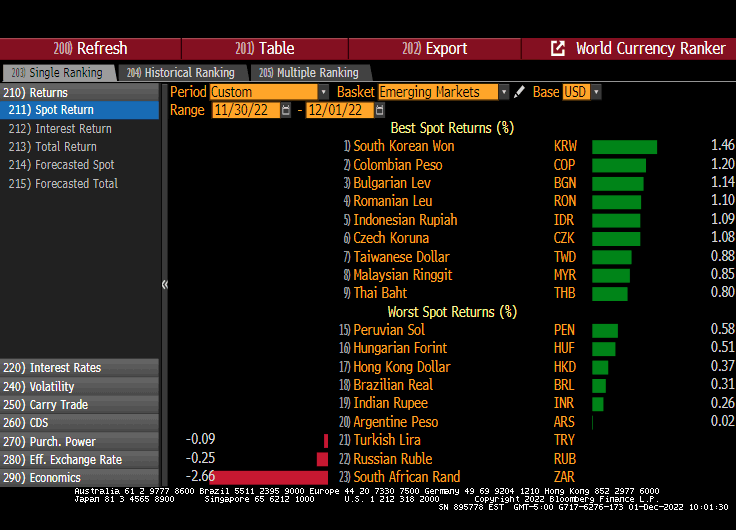Markets React to Year-End Surprises
01 December 2022
Read Time 2 MIN
Market Liquidity
We are getting closer to year-end, when liquidity traditionally gets tighter, and this means that economic and political surprises might have a disproportionate impact on asset prices. We could see this effect yesterday after U.S. Federal Reserve (Fed) Chairman Powell’s presentation – which was not truly surprising substance-wise (given what was priced in by the Fed Funds Futures – a smaller 50bps hike in December), but which nevertheless spurred a sizable market rally. Today’s weaker than expected U.S. ISM survey1 – including yet another decline in the prices paid index (to mere 43.0) – is consistent with the slowing pace of rate hikes in the U.S.
South Africa Impeachment Crisis
News reports about potential impeachment proceedings against South Africa’s President Cyril Ramaphosa also produced an oversized reaction. The rand weakened by 266bps against U.S. dollar (as of 10:00am ET, according to Bloomberg LP – see chart below), 5-year CDS widened by 27bps, and the 10-year government bond yield jumped by 71bps. Observers are still divided as to whether this is a soft coup attempt or a sign that institutions work, at least in some emerging markets (EM), i.e., politicians/officials face consequences if they transgress. But many see a significant probability that Ramaphosa will not have to resign. Further, South Africa’s history shows that even if the president steps down, the transition process should be managed well. One big question – after the dust settles one way or another – is whether the current crisis will compromise South Africa’s reform agenda to the extent that threatens the country’s growth outlook and the fiscal adjustment process and debt sustainability.
Global Slowdown
The biggest “congregation” of today’s economic surprises was in the global growth area. China’s Caixin manufacturing PMI2 (Purchasing Managers Index) actually improved in November – imagine what could happen if the re-opening gains pace. Activity gauges in parts of EM Asia (India, Philippines, Thailand) looked good, and we also got a major unexpected spike in Hungary (to 54.7), which tells us that the central bank’s policy stance should remain tight for the time being. However, the situation in Hungary’s regional peers – Poland and the Czech Republic – is much more concerning. The November PMIs in both countries stayed deep in contraction zone, putting more pressure on central banks to stay on hold. Another massive downside surprise came from Brazil – the manufacturing PMI collapsed from 50.8 to 44.3, drawing attention to the elections’ impact on confidence (and hence, on the government’s ability to meet its fiscal targets). Stay tuned!
Chart at a Glance: South African Currency Hit By Political Turbulence

Source: Bloomberg LP.
1 The ISM survey is a monthly indicator of U.S. economic activity based on a survey of purchasing managers at more than 300 manufacturing firms. It is considered to be a key indicator of the state of the U.S. economy.
2 The Caixin manufacturing PMI is a gauge of activity in China's manufacturing sector.
Related Insights
IMPORTANT DEFINITIONS & DISCLOSURES
This material may only be used outside of the United States.
This is not an offer to buy or sell, or a recommendation of any offer to buy or sell any of the securities mentioned herein. Fund holdings will vary. For a complete list of holdings in VanEck Mutual Funds and VanEck ETFs, please visit our website at www.vaneck.com.
The information presented does not involve the rendering of personalized investment, financial, legal, or tax advice. Certain statements contained herein may constitute projections, forecasts and other forward looking statements, which do not reflect actual results. Information provided by third-party sources are believed to be reliable and have not been independently verified for accuracy or completeness and cannot be guaranteed. Any opinions, projections, forecasts, and forward-looking statements presented herein are valid as of the date of this communication and are subject to change without notice. The information herein represents the opinion of the author(s), but not necessarily those of VanEck.
The views contained herein are not to be taken as advice or a recommendation to buy or sell any investment in any jurisdiction, nor is it a commitment from Van Eck Associates Corporation or its subsidiaries to participate in any transactions in any companies mentioned herein. This content is published in the United States. Investors are subject to securities and tax regulations within their applicable jurisdictions that are not addressed herein.
All investing is subject to risk, including the possible loss of the money you invest. As with any investment strategy, there is no guarantee that investment objectives will be met and investors may lose money. Diversification does not ensure a profit or protect against a loss in a declining market. Past performance is no guarantee of future results.
